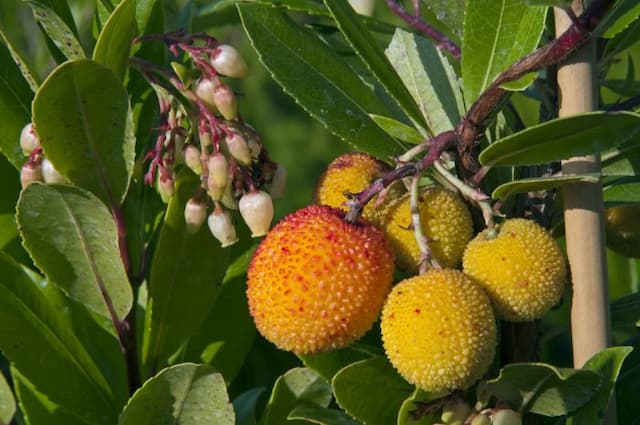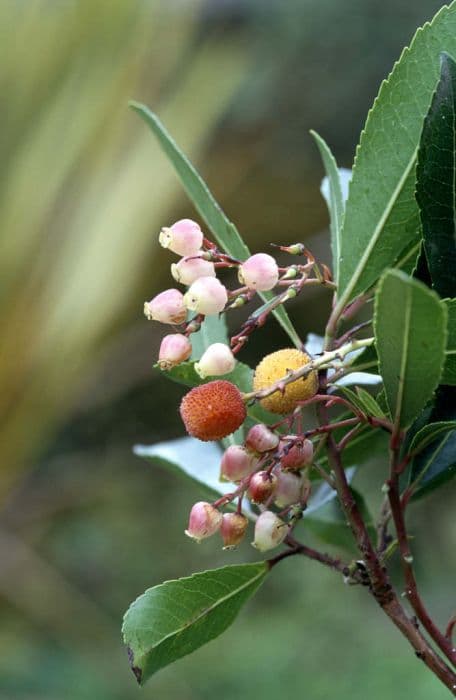Prickly Heath Gaultheria mucronata 'Wintertime' (f)

ABOUT
Gaultheria mucronata 'Wintertime', also known as prickly heath, is an evergreen shrub characterized by its glossy, dark green leaves that contrast beautifully with the striking berries it produces. The leaves are small, ovate to lanceolate in shape, and often have spine-tipped margins, giving the plant its common name. Throughout the seasons, the foliage maintains its lush appearance, providing a constant backdrop for the other features of the plant. The most noticeable aspect of prickly heath 'Wintertime' is its berries. They are prominent, spherical, and can come in a variety of colors, including white, pink, red, or purple. These berries create an eye-catching display that can last through winter, hence the cultivar name 'Wintertime'. Each berry is perched atop its own slender stem, nestled among the leaves, and may have a subtle shine, catching the light and drawing attention. Additionally, prickly heath produces delicate flowers that are urn-shaped and typically white or pale pink. These flowers are much smaller than the berries and bloom before the berries form. They are less noticeable but add an extra layer of interest for those who look closely, providing a soft contrast to the bolder statement of the berries and leaves. The overall impact of Gaultheria mucronata 'Wintertime' is one of hardy grace, offering visual interest in garden settings that favor evergreens and plants with winter appeal.
About this plant
 Names
NamesFamily
Ericaceae.
Synonyms
Prickly Heath, Pernettya.
Common names
Gaultheria mucronata (L. f.) Hook. & Arn., Pernettya mucronata (L. f.) G.Don, Gaultheria mucronata var. mucronata, Pernettya mucronata var. mucronata.
 Toxicity
ToxicityTo humans
Gaultheria mucronata, commonly known as prickly heath, is not widely documented as a poisonous plant to humans. However, care should be taken as some individuals may have sensitivity to certain plants. If ingested in large quantities, it could lead to stomach upset or discomfort. To be cautious, avoid consuming any parts of the prickly heath plant, and it is always advisable to consult medical professionals if ingestion occurs and negative symptoms appear.
To pets
Regarding pets, prickly heath (Gaultheria mucronata) is not commonly listed as a toxic plant. Nevertheless, pets can have unique sensitivities and varying reactions to plants, much like humans. Consumption of parts of the plant, especially in significant amounts, might cause mild digestive upset in some pets. To ensure pet safety, prevent your animals from ingesting the plant and consult with a veterinarian if your pet shows signs of distress after ingestion.
 Characteristics
CharacteristicsLife cycle
Perennials
Foliage type
Evergreen
Color of leaves
Green
Flower color
White
Height
3 feet (0.91 meters)
Spread
3 feet (0.91 meters)
Plant type
Shrub
Hardiness zones
7
Native area
South America
Benefits
 General Benefits
General Benefits- Ornamental Appeal: Gaultheria mucronata 'Wintertime', commonly known as Pernettya, features attractive berries and evergreen foliage that enhance garden aesthetics year-round.
- Wildlife Attraction: The berries produced by Pernettya can attract birds and other wildlife to your garden, providing a food source and encouraging biodiversity.
- Low Maintenance: Pernettya is known for being a low-maintenance plant, requiring minimal care once established, thus suitable for busy or novice gardeners.
- Hardiness: This plant is able to withstand cold temperatures, making it an ideal choice for gardens in temperate regions.
- Ground Cover: Pernettya can serve as an effective ground cover, limiting the growth of weeds by covering the soil surface.
- Seasonal Interest: With its vibrant berries and foliage, Pernettya adds color to the garden, especially in the fall and winter when other plants may have died back.
- Container Gardening: Suitable for growing in containers, Pernettya can be easily placed on patios, balconies, or other areas where ground planting is not possible.
- Soil Adaptation: It can adapt to a variety of soil types, although it prefers acidic conditions, making it versatile for different garden environments.
- Erosion Control: With its dense growth habit, Pernettya can help prevent soil erosion on sloped terrain.
- Pollinator Friendly: While the flowers are not particularly showy, they can provide nectar for bees and other pollinating insects in the spring.
 Medical Properties
Medical PropertiesThis plant is not used for medical purposes.
 Air-purifying Qualities
Air-purifying QualitiesThis plant is not specifically known for air purifying qualities.
 Other Uses
Other Uses- Natural dye – The berries of the 'Wintertime' plant can be used to produce natural dyes for textiles or crafting purposes, giving fabrics a subtle color.
- Garden Borders – 'Wintertime' can be planted as an attractive garden border, showcasing its evergreen foliage and colorful berries.
- Wildlife Shelter – The dense growth habit of the plant provides excellent shelter for birds and other small wildlife in the garden.
- Floral Arrangements – Its attractive foliage and colorful berries can be used to enhance floral arrangements or wreaths, especially during the holiday season.
- Photography – Owing to their beautiful berries and foliage, 'Wintertime' plants can be great subjects for nature photography.
- Erosion Control – The plant can be used on sloping gardens to help prevent soil erosion due to its dense rooting system.
- Frosty Garden Theme – The red berries and frost-resistant leaves are suitable for creating a winter-themed garden landscape.
- Bonsai – With proper training and pruning, 'Wintertime' can be shaped into a bonsai for ornamental indoor or outdoor gardening.
- Craft Projects – Dried berries and clipped foliage can be used in various craft projects, from making natural jewelry to decorating picture frames.
- Educational Use – The plant could be used in educational settings such as schools or botanical gardens to teach about plant life cycles, particularly fruit development and bird-plant interactions.
Interesting Facts
 Feng Shui
Feng ShuiThe plant_name is not used in Feng Shui practice.
 Zodiac Sign Compitability
Zodiac Sign CompitabilityThe plant_name is not used in astrology practice.
 Plant Symbolism
Plant Symbolism- Resilience: Gaultheria mucronata, commonly known as prickly heath, often exhibits the ability to thrive in challenging conditions, symbolizing the resilience and hardiness of the plant and by extension, the same traits in individuals or circumstances it represents.
- Protection: The prickly nature of this plant suggests a symbolism of protection, as its spikes can deter animals and unwanted interactions, representing a guard against negativity.
- Winter Beauty: As 'Wintertime' suggests, this variety of Gaultheria reminds us of the beauty that can be found in the coldest season, symbolizing appreciation for beauty in all times and the ability to stand out during bleak or challenging times.
- Renewal: Despite enduring cold winters, prickly heath bursts forth with life in the spring, making it a symbol of renewal, hope, and the promise of new beginnings after a period of dormancy or hardship.
 Water
WaterPernettya requires consistently moist soil, so watering should be done thoroughly to keep the soil from drying out. Water when the top inch of soil feels dry to the touch, which may be about once a week. The exact frequency will depend on climate conditions and indoor heating. When watering, use room temperature water, and apply it gently to the base of the plant until it begins to drain from the bottom of the pot. Aim to use approximately half a gallon every two weeks, adjusting as necessary for the plant's environment and pot size to ensure the soil remains evenly moist but not waterlogged.
 Light
LightPernettya thrives in bright, indirect light, making it well-suited for a spot that receives diffused sunlight such as a location near a window with a sheer curtain. Avoid direct sunlight as it can scorch the leaves, and steer clear of excessively dark corners where the light is insufficient for healthy growth. Eastern or northern-facing windows are often ideal locations for providing the right amount of light.
 Temperature
TemperaturePernettya prefers cooler temperatures and can generally tolerate a range between 50°F and 70°F. Avoid places with drastic temperature changes or where the plant might be exposed to cold drafts or heating vents. The ideal temperature for this plant to thrive would be around 60°F to 65°F. Ensure protection during winter as Pernettya should not be exposed to temperatures below 30°F.
 Pruning
PruningPernettya should be pruned to maintain its shape and encourage dense growth. Pruning is best done in late winter or early spring before new growth begins. Thin out any crowded branches and trim back to maintain size and shape. While Pernettya doesn't require heavy pruning, removing dead or damaged wood periodically will promote the overall health of the plant.
 Cleaning
CleaningAs needed
 Soil
SoilThe best soil mix for Gaultheria mucronata 'Wintertime', commonly known as Pernettya, is a well-draining acidic mix with a pH of 4.5 to 6.0. A mixture of peat moss, sand, and pine bark will provide the appropriate conditions for healthy growth.
 Repotting
RepottingPernettya should be repotted every 2-3 years to prevent becoming root-bound and to refresh the soil. Choose a slightly larger pot each time to allow for growth.
 Humidity & Misting
Humidity & MistingPernettya thrives at a moderate humidity level of about 50-60%. Avoid placing the plant in overly dry environments, which may necessitate the use of a humidifier or pebble trays to maintain adequate humidity.
 Suitable locations
Suitable locationsIndoor
Plant in acidic soil, moderate light, and keep soil moist.
Outdoor
Plant in dappled shade, acidic soil, and protect from harsh sun.
Hardiness zone
7-10 USDA
 Life cycle
Life cycleGaultheria mucronata 'Wintertime', commonly known as the Pernettya, begins its life cycle from seeds that germinate in moist, well-drained soil, ideally in partial shade. The seedlings establish themselves with a dense root system and grow into evergreen shrubs with dark glossy leaves and a rounded habit. During spring, it enters the flowering stage, producing small, bell-shaped flowers that are often white or pink, which are followed by the development of striking, berry-like fruits in autumn, ranging in color from white to pink to deep purple. Throughout the growing season, the Pernettya requires consistent moisture and may benefit from fertilizer to support healthy growth. Over the years, the shrub matures and thickens, reaching a size of up to 1.5 meters tall, requiring occasional pruning to maintain shape and encourage new growth. Although it is an evergreen, the Pernettya may shed some leaves as part of its natural cycle but remains visually appealing year-round, especially in winter when the colorful berries stand out against the foliage.
 Propogation
PropogationPropogation time
Early spring
Propogation: The Gaultheria mucronata 'Wintertime', commonly known as Pernettya, is best propagated during the late winter to early spring months when the plant is not in active growth. The most popular method of propagation for this particular shrub is through semi-hardwood cuttings. This involves taking a cutting of about 4 to 6 inches (10 to 15 centimeters) from a healthy, semi-matured branch. The bottom leaves are removed, and the cut end is dipped in rooting hormone to encourage root development. The cutting is then planted in a mixture of peat and perlite and kept under conditions of high humidity and indirect light. After a few weeks, when the cuttings have developed roots, they can be potted up into individual containers to grow on.









